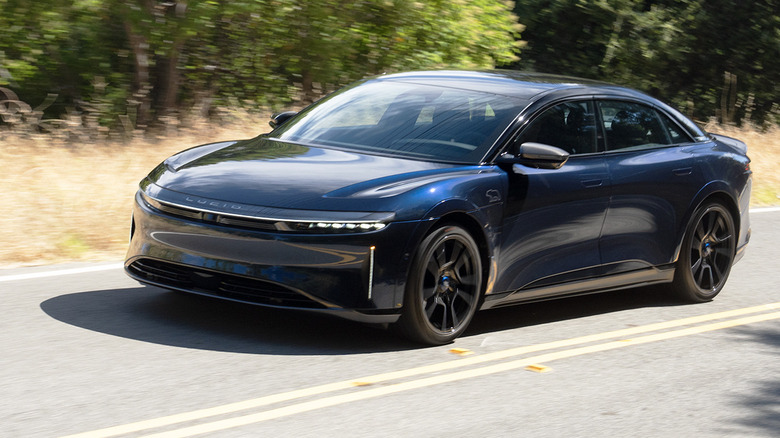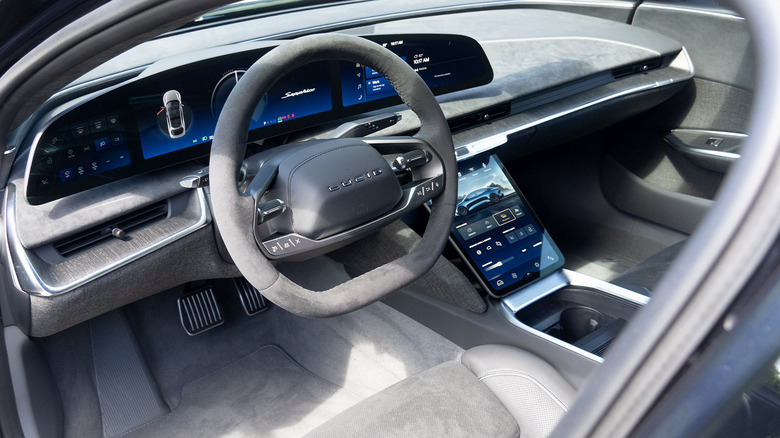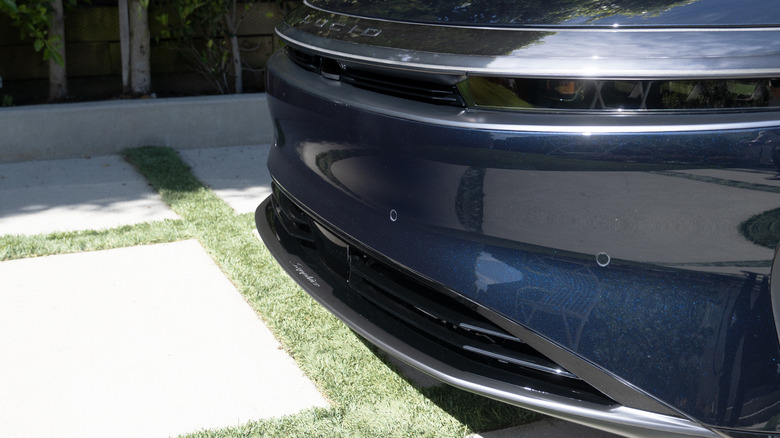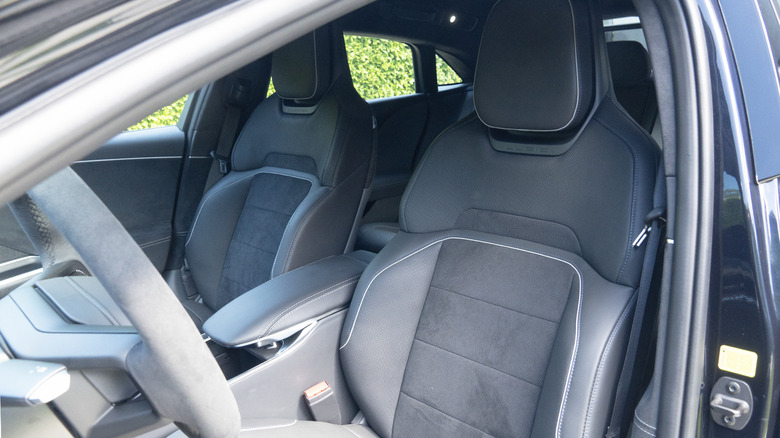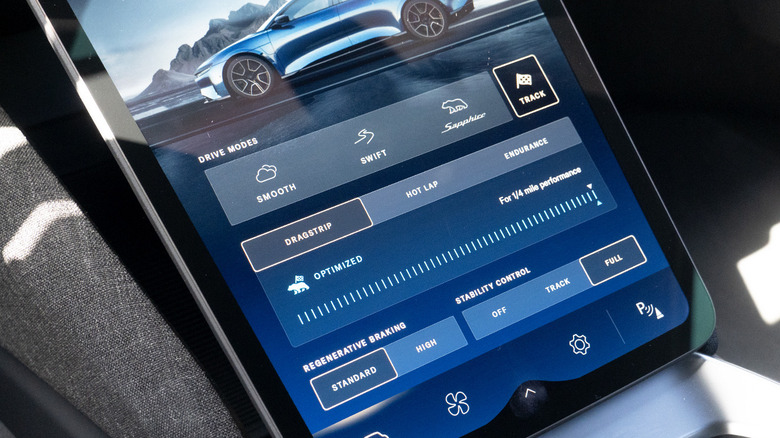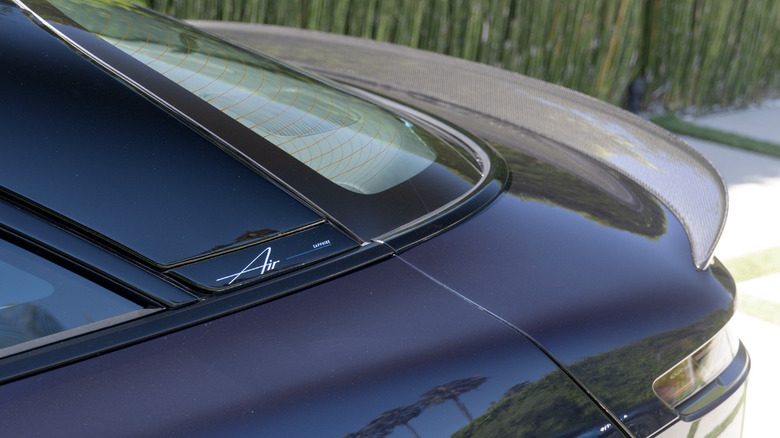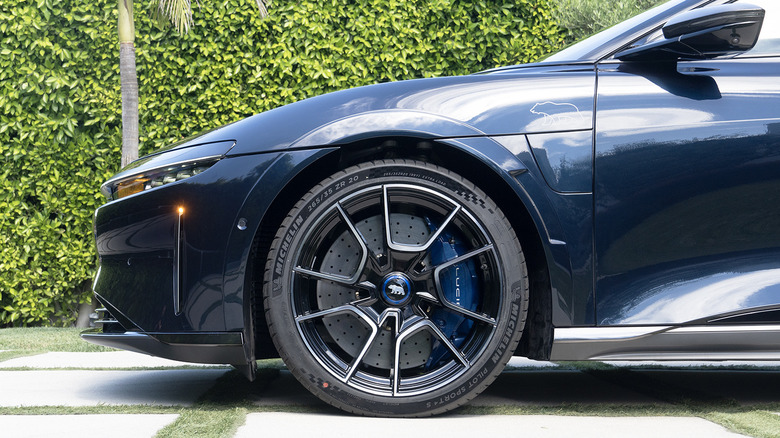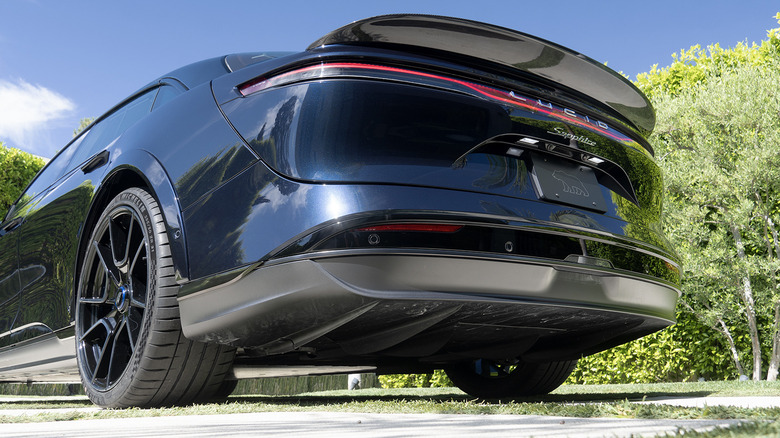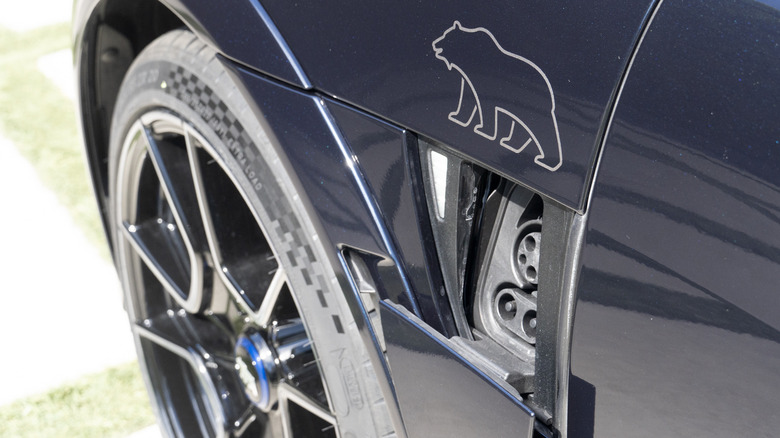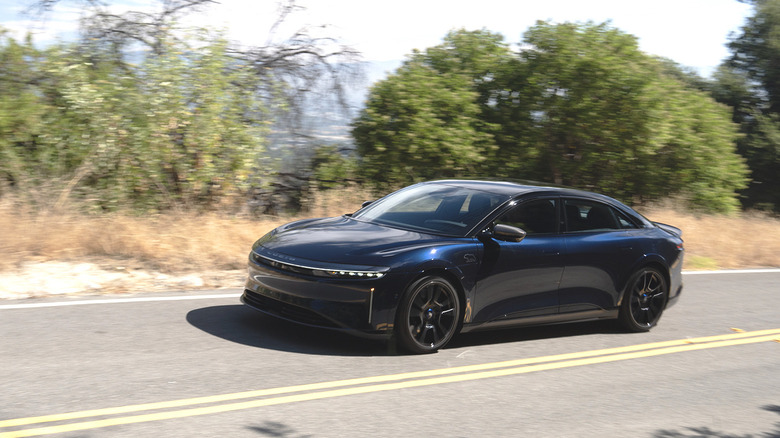2024 Lucid Air Sapphire First Drive: Supercar-Shaming EV Outshines Plaid
Nobody in their right mind can call any version of the Lucid Air slow. Even the most affordable Air in Pure trim delivers effortless power at any time, from hard launches off stop signs to highway passing well into triple digits. But the big batteries that allow for Lucid's world-beating range estimates also add plenty of weight, so the Pure's reduced output—at "only" 480 horsepower—pales a bit in comparison to the highest-spec Grand Touring Performance's 1,050 ponies.
That GTP formerly occupied rarefied air (pun fully intended) as the fastest car I'd ever driven. Until now, that is. Surprise, surprise! The new fastest car I've ever driven once more comes courtesy of Lucid: The all-new range-topping undisputed heavyweight champ of EVs, the tri-motor Sapphire trim that takes Air even further upmarket with a $249,000 price tag and the kind of stupefying performance that can legitimately keep up with hypercars.
A fun first run in the new Lucid Air Sapphire
Hypercar performance from a luxurious four-door sedan? The Sapphire requires no exaggeration, as I learn the first time out on Mulholland Drive with Lucid Chassis and Vehicle Dynamics Director David Lickfold in the passenger seat urging me to punch it as a straightaway approaches. Batteries preconditioned, motors and tires warmed up, and my head pressed firmly back into the headrest to prevent potential neck injuries, I oblige.
That old rollercoaster feeling in my stomach wells up, even as all four tires scrabble for traction before the surge fully, truly hits. Unbelieveable, unrelenting, ungodly—and all too soon, undoubtedly illegal. I think once more of the hilarious scientific term for the rate of change of acceleration: jerk. I'm driving like one, unnecessarily but in the name of science, before I hammer the brakes and drop back to Earth.
Experiencing otherworldly acceleration in the real world
Lucid promised 1,200 horsepower and a 0-60 time under two seconds for the Sapphire over a year ago. Brace yourself for the official stats: fully 1,234 hp with 1,420 lb-ft of instantaneously available torque. The real-world 0-60 time is a joke, at 1.89 seconds—that's almost as quick as the $2 million Rimac Nevera. The Sapphire, meanwhile, seats five and will hit 100 mph faster than even fast cars hit 60, in only 3.84 seconds. A quarter-mile whips by in 8.95 seconds at 158 miles per hour, and Lickfold tells me the car pulls hard right up to the electronically limited top speed of 205 mph, only instituted due to the speed ratings of the Michelin Pilot Sport 4S tires.
Though public roads and whatever sanity I have left prevented me from venturing too far into triple digits, I believe him. Lucid originally designed the Air exactly for this purpose, with space for three motors including two snugged in as a single unit at the rear axle (the power unit that attracted Aston Martin, for good reason). The perfect packaging allows Sapphire to still provide the sumptuously spacious interior of other Air variants, with a cavernous trunk and huge frunk that sacrifice exactly zero cubic feet to the demands of overwhelming acceleration.
An engineer's dream job
But dropping a pair of motors between the rear tires also afforded Lickfold and his team a chance to play with torque vectoring, making Sapphire about much more than simple straight-line speed.
"Sapphire was a chance to take the existing Air and just gonna turn up the dial on the performance side," Lickfold said. "Obviously with three motors on this car, a whole load more torque, whole load more power. And we were given scope to basically go wild."
But the engineering team apparently split about the best way, exactly, to go completely wild. On one side, Lickfold wanted to tune the tri-motor power delivery to allow for raucous sideways drifting, all burnt rubber and countersteer for the sheer silly hoonigan lurking inside every speed freak. On the other hand, Lucid's spectacular chassis composure prompted others to program more Scandinavian rally-style torque delivery, where setting the steering angle with patience allows the front wheels to pull through a predictable arc into and out of corner apex. This is Sapphire, though, so the final decision seems simple enough: Why not both?
Drive modes at the edge of sanity
The new drive modes show exactly how much of an engineer's dream job this project must have been. Smooth and Swift carry over from lower-spec Airs, but Sapphire mode replaces the former Sprint setting. All feature revisions to the suspension damping, steering, brake boost, power, and torque distribution. A new Track mode to the right of Sapphire on the central touchscreen preconditions the batteries and motors to 25°Celsius (77° Fahrenheit) and opens up the choice between Dragstrip, Hot Lap, and Endurance prioritization of power delivery.
As the name suggests, Dragstrip sets the drivetrain up for maximum power delivery over a quarter-mile pull, Hot Lap manages heat soak for an imaginary trip around Virginia International Raceway at full 10/10ths effort, and Endurance allows for between six and eight laps before needing a break to charge and cool. A nifty Optimized bar gauge displays the drivetrain's status when in any of the Track modes.
Lickfold also explained that turning Stability Control to Off, a feature we declined to play with in the hills above West Los Angeles, does not quite deactivate the traction control entirely, which would result in the wheels immediately spinning up to infinity (and very possibly, beyond). Instead, the program allows plenty of slip angle while building up inertia in the drivetrain to mimic a V8 spun up for drifting. And drifting, technically speaking, isn't fast: for the best lap times, wiser minds might set the Stability Control to Track.
Torque vectoring delivers
As I hammer the Sapphire through wide bends on Mulholland and Sepulveda, Lickfold let the real picture unfold better than his (and my) engineering explanations can possibly hope to convey. First, I took an easy lefthander in Smooth and felt up to 750 horsepower spool up as I unwound the steering wheel back into a straightaway. Next up, he switched us into Swift, immediately unleashing more power all the way through the next sweeper, but never enough to make the tires start squealing.
Finally, he gave me the requisite warning and put us in Sapphire mode. That's a bingo, time for the fun to start. Sure enough, that torque vectoring shines through immediately, with just the right amount of oversteer allowed as the Michelins began to protest. In Sapphire, I never matted through a corner lest this pre-production car meet an early demise over a cliffside with those 1,234 ponies and our poor souls trapped inside. Even nudging my right foot into the go pedal set the tires on edge, though, revealing once again how much of Lucid's brilliant chassis tuning harkens back to the engineers, including CEO and CTO Peter Rawlinson, who once worked at Lotus. Pure magic amid the anxious expectancy of when the next straightaway might rearrange our guts.
Wheels and tires make all the difference
Lucid mounts its Michelins on staggered 20 and 21-inch wheels, the latter measuring an inch taller than the biggest available on the Pure. But on the Pure, optioning the 20-inchers drops the all-important range figure down to only 384 miles, versus 410 miles with 19s—not great, and not worth the stylistic improvement to my eye. More importantly, quite surprising that wheels and tires can make such a difference.
To help overcome such concerns, Sapphire will launch with a second generation of Lucid's aero discs available as an option for the wheels. But Lucid also developed the Sapphire's Pilot Sport 4S tires with Michelin specifically to optimize range: they have a hard compound on the center of the tread, which transitions to essentially Cup 2 rubber on the shoulder so that, when called upon, grip dutifully increases.
And the tires do lean, without a doubt and almost more noticeably than anything this side of off-roading, because the Sapphire adds around 150 pounds to the Pure's curb weight, for a total of 5,336 pounds. The extra motor only explains part of that additional weight, though, because the Sapphire also gets a 118-kWh battery that allows for an absurd EPA-official 427 miles of range. Yep, that's more than any EV currently on the market not built by Lucid—not bad for the fastest car I've ever driven, and one that mostly manages to mask the overall weight during spirited driving.
Mechanical upgrades at the limit of performance
The Sapphire's suspension revisions help to firm up any body roll with stiffer springs, retuned dampers, beefier sway bars, and even higher durometer bushings. Slight modification to the control arms and front knuckles also creates a bit more negative camber for the tires, which measure 265 millimeters wide up front and 295 out back. Wider rubber means a wider track and a wider track needs coverage according to law in most states, so the Sapphire also needed the set of fender flares that add a distinctive look to the already-wide spaceship aesthetic, with a front splitter, side skirts, rear diffuser, and carbon-fiber rear spoiler rounding out the obvious stylistic revisions.
The aero bits increase downforce at speed in addition to enhancing the performance profile. Even more eye-catching, though, are the carbon-ceramic brakes installed to combat all that power and weight. Massive 10-piston calipers chomp down on rotors measuring 420 millimeters up front, with four-pistons for 390-mm discs at the rear. Aero discs would cover those stunning brakes, so perhaps we know why Lucid opted not to install them on this press car. And in fact, the braking power increased so much, Lickfold told me, that a full recalibration of the ESC, traction control, and ABS became necessary—helping prompt Lucid to develop a new traction-control system in-house that performs computations every single millisecond, rather than every 20 when using the former first-tier supplier's programming. The new level of refinement can go both ways, improving traction during normal driving but also modulating a lack of traction on purpose, as well.
Diffferentiating Sapphire from other Air trims
The lower suspension's additional firmness shows up immediately, without impinging excessively on the luxurious ride that Lucid's most expensive car to-date needs to deliver. As an added bonus, lowering the body over larger wheels and lower-profile tires also finally nails the stance that designer Derek Jenkins always envisioned for Air. But I wanted to know how else Lucid plans to differentiate Sapphire Airs from the lowest-spec Pure, especially because the Pure still feels so eminently luxurious, even in comparison to more expensive configurations.
"This is meant to be a halo product and, quite frankly, to shed more light on the Pures and Tourings and Grand Tourings," Jenkins told me. "We put so much effort into range and efficiency with Air that, when you start to go to the next level of performance, it opens up some opportunities from a design standpoint: wheels, spoilers, fender flares, things that you would not do on the normal vehicle because it would degrade our range capability."
On the interior, my immediate favorite upgrade actually improved on one of my favorite aspects of all the previous Airs I've driven (and ridden in as a passenger). A set of seriously bolstered sports seats, still almost infinitely adjustable of course, just perfectly fit my frame (at 6'1" with long legs and a small torso). More importantly, once out on the road up and solemnly up to no good with Lickfold, the bolsters pinned me in tight as the g forces mounted thanks to those suspension upgrades and unique tires.
How much do you wanna spend?
Jenkins also pointed out the new Sapphire theme on all the touchscreens, a dark blue shade to match the sparkling metallic paint job–that shifts colors depending on light and viewing angle–itself contrasting with carbon fiber used for mirror caps and the substantial rear wing. A heavy dose of Alcantara also stands out on many interior surfaces, including the headliner for the solid aluminum roof. There's no glass panorama here, to my great surprise and gratitude on a scorching summer day when I wanted as much of the car's energy as possible going towards performance rather than climate control.
Throughout my time with Sapphire and the Lucid team, that old aphorism about racing budgets kept creeping into my head: "How fast do you wanna go?" and the inevitable answer, "How much do you wanna spend?" Do all the performance and cosmetic enhancements justify an ask starting at a quarter-million bucks?
Lucid recognizes that the Pure, and any forthcoming models at lower price points, will make up the meat of their EV market. But halo models make headlines, an especially important consideration for a startup still in the infant stages of public recognition. Short of a highlighter-neon or Barbie-themed paint job, building the most hardcore super-sedan on the planet might just be the best bet for reaching the hearts and minds that need to know all about the entire electric Air lineup.
